Alice Neel: Painted Truths, Whitechapel Gallery | reviews, news & interviews
Alice Neel: Painted Truths, Whitechapel Gallery
Alice Neel: Painted Truths, Whitechapel Gallery
Neel wanted to get under the skin of her sitters. Her unflinching gaze served her well
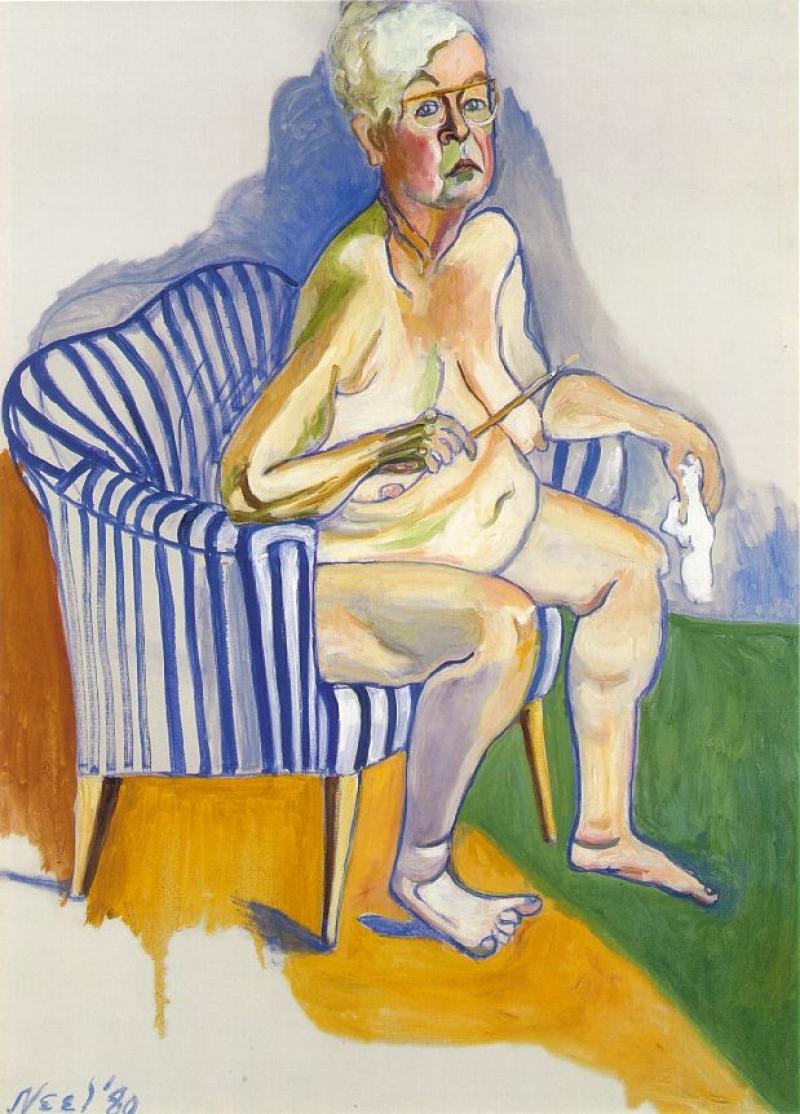
What a troubled life Alice Neel led.
And yet we find her, in variously dated archive footage featured in the 90-minute film that accompanies this retrospective, surprising us with her frequent girlish smiles. For all her matronly girth in old age, she looks fragile, but not defeated.
Yet that’s not how she painted herself. In her only self-portrait (main picture), painted in 1980, four years before her death, she looks formidable. Aged 80, naked and with a spindly brush in one hand and a rag in the other, she belies, with her fearsome look, her physical vulnerability: the stubbornly down-turned mouth, an eyebrow raised in a disdainful and defiant arch (disdainful, perhaps, of her own reflection or of us); and her hair like a steel helmet, not the mass of grey, formless, candyfloss we see in the film.
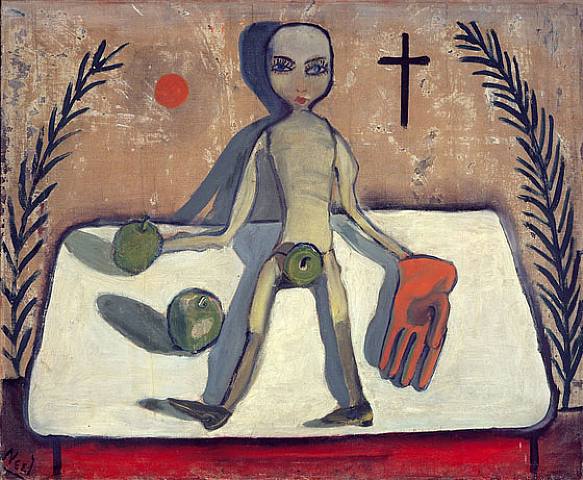 Neel wasn’t much interested in straightforward realism, though her sitters are always recognisably themselves. Instead she wanted to get at something a little harder: psychological truth. People were “psychological” she’d say. She approached all her sitters with this end in mind.
Neel wasn’t much interested in straightforward realism, though her sitters are always recognisably themselves. Instead she wanted to get at something a little harder: psychological truth. People were “psychological” she’d say. She approached all her sitters with this end in mind.
But before we get to the full flourishing of her talents as a portraitist – her acute eye serving her by turns with its detached gaze, its empathy or, indeed, distain, we begin this often poignant exhibition with Neel confronting the loss of her children. Given her feelings of maternal inadequacy, her early work is, unsurprisingly, disturbing. Futility of Effort, 1930, is a sparse, grey painting which features a doll-like figure of a little girl trapped, perhaps strangled, as the labelling suggests, through the bedposts at the end of her bed. Degenerate Madonna, 1930, shows the influence of German Expressionism, though its mannered stylisation hides nothing of the pitiless rawness of self-hatred. In Symbols (Doll and Apple), c 1933 (pictured above right), another doll-child sits slumped and twisted-limbed, surrounded by Christian imagery. Its style is that of the Latin American devotional painting. More perplexingly, an apple hides its genitals, another apple is held in one hand and a huge red glove is worn in the other. It was painted soon after Neel was discharged from a hospital following her mental breakdown.
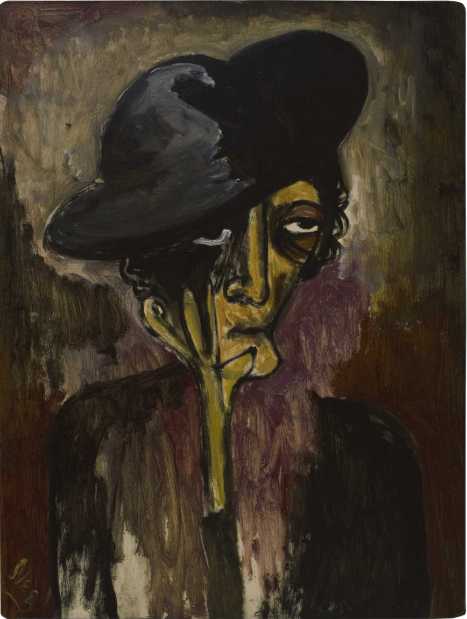 You can see Neel’s style shift according to who she was painting and what he or she represented. She even flirts with socialist realism. Pat Whalen, 1935, shows the fervently committed Communist staring into the middle-distance of a promised future, his heavy, oversized fists clenched over a copy of the Daily Worker, the organ of the Communist Party USA (CPUSA). Elsewhere, heavily worn Neue Sachlichkeit caricature informs her painting of Audrey McMahon, 1940 (pictured left). McMahon was the director of the New York division of the New Deal’s Federal Art Project and was an unpopular figure among many artists, including Neel. McMahon stares out of the canvas with a face as brown and as hard and as shrunken as a shrivelled nut.
You can see Neel’s style shift according to who she was painting and what he or she represented. She even flirts with socialist realism. Pat Whalen, 1935, shows the fervently committed Communist staring into the middle-distance of a promised future, his heavy, oversized fists clenched over a copy of the Daily Worker, the organ of the Communist Party USA (CPUSA). Elsewhere, heavily worn Neue Sachlichkeit caricature informs her painting of Audrey McMahon, 1940 (pictured left). McMahon was the director of the New York division of the New Deal’s Federal Art Project and was an unpopular figure among many artists, including Neel. McMahon stares out of the canvas with a face as brown and as hard and as shrunken as a shrivelled nut.
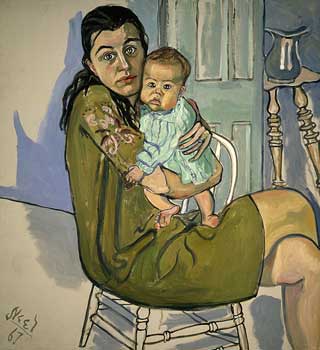 It is not until the Sixties that Neel’s dense, dark palette lifts, and she becomes thoroughly and recognisably "Alice Neel". She begins to paint fellow artists, curators and writers but also returns again and again to the theme of Mother and Child. These are unlike the earlier Degenerate Madonna, yet many unflinchingly depict the anxiety and often sheer shock of new motherhood. Among the most arresting – and I think one of the strongest paintings in the exhibition – is Mother and Child (Nancy and Olivia), 1967 (pictured right). Neel’s daughter-in-law sits hugging her baby as if it were a life buoy and her saucer-wide eyes betray her utter bewilderment. A later portrait of Nancy with five-month-old twins, painted in 1971, shows someone altogether more practised at motherhood, transformed by self-assurance.
It is not until the Sixties that Neel’s dense, dark palette lifts, and she becomes thoroughly and recognisably "Alice Neel". She begins to paint fellow artists, curators and writers but also returns again and again to the theme of Mother and Child. These are unlike the earlier Degenerate Madonna, yet many unflinchingly depict the anxiety and often sheer shock of new motherhood. Among the most arresting – and I think one of the strongest paintings in the exhibition – is Mother and Child (Nancy and Olivia), 1967 (pictured right). Neel’s daughter-in-law sits hugging her baby as if it were a life buoy and her saucer-wide eyes betray her utter bewilderment. A later portrait of Nancy with five-month-old twins, painted in 1971, shows someone altogether more practised at motherhood, transformed by self-assurance.
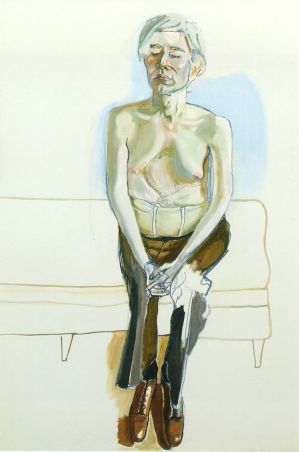 Neel was always interested in getting under the skin of her sitters and one certainly feels her portrait of Andy Warhol (pictured left) – an artist whose interest lay only in surface – achieves this. At the very least it succeeds in portraying the humanity behind the almost impenetrable coolness of his image. Painted in 1970, two years after his near fatal shooting by Factory hanger-on/stalker Valerie Solanas, Warhol sits on a cartoon outline of a sofa. He is stripped to the waist, his eyes closed. He might be inwardly flinching at our unwavering gaze, but his face conveys dignified self-possession.
Neel was always interested in getting under the skin of her sitters and one certainly feels her portrait of Andy Warhol (pictured left) – an artist whose interest lay only in surface – achieves this. At the very least it succeeds in portraying the humanity behind the almost impenetrable coolness of his image. Painted in 1970, two years after his near fatal shooting by Factory hanger-on/stalker Valerie Solanas, Warhol sits on a cartoon outline of a sofa. He is stripped to the waist, his eyes closed. He might be inwardly flinching at our unwavering gaze, but his face conveys dignified self-possession.
We survey the scars of his gunshot wounds, his pendulous man-breasts, the bulging surgical corset. His frame is fragile, almost feminine. And the paint is so thinly applied that he looks ethereal, his feet barely anchored to the ground. He might float off at any moment. We, however, are rooted to the spot.
- Alice Neel: Painted Truths at Whitechapel Gallery until 17 September
Share this article
Add comment
The future of Arts Journalism
You can stop theartsdesk.com closing!
We urgently need financing to survive. Our fundraising drive has thus far raised £49,000 but we need to reach £100,000 or we will be forced to close. Please contribute here: https://gofund.me/c3f6033d
And if you can forward this information to anyone who might assist, we’d be grateful.

Subscribe to theartsdesk.com
Thank you for continuing to read our work on theartsdesk.com. For unlimited access to every article in its entirety, including our archive of more than 15,000 pieces, we're asking for £5 per month or £40 per year. We feel it's a very good deal, and hope you do too.
To take a subscription now simply click here.
And if you're looking for that extra gift for a friend or family member, why not treat them to a theartsdesk.com gift subscription?
more Visual arts
 'We are bowled over!' Thank you for your messages of love and support
Much-appreciated words of commendation from readers and the cultural community
'We are bowled over!' Thank you for your messages of love and support
Much-appreciated words of commendation from readers and the cultural community
 Kerry James Marshall: The Histories, Royal Academy review - a triumphant celebration of blackness
Room after room of glorious paintings
Kerry James Marshall: The Histories, Royal Academy review - a triumphant celebration of blackness
Room after room of glorious paintings
 Folkestone Triennial 2025 - landscape, seascape, art lovers' escape
Locally rooted festival brings home many but not all global concerns
Folkestone Triennial 2025 - landscape, seascape, art lovers' escape
Locally rooted festival brings home many but not all global concerns
 Sir Brian Clarke (1953-2025) - a personal tribute
Remembering an artist with a gift for the transcendent
Sir Brian Clarke (1953-2025) - a personal tribute
Remembering an artist with a gift for the transcendent
 Emily Kam Kngwarray, Tate Modern review - glimpses of another world
Pictures that are an affirmation of belonging
Emily Kam Kngwarray, Tate Modern review - glimpses of another world
Pictures that are an affirmation of belonging
 Kiefer / Van Gogh, Royal Academy review - a pairing of opposites
Small scale intensity meets large scale melodrama
Kiefer / Van Gogh, Royal Academy review - a pairing of opposites
Small scale intensity meets large scale melodrama
 Jenny Saville: The Anatomy of Painting, National Portrait Gallery review - a protégé losing her way
A brilliant painter in search of a worthwhile subject
Jenny Saville: The Anatomy of Painting, National Portrait Gallery review - a protégé losing her way
A brilliant painter in search of a worthwhile subject
 Abstract Erotic, Courtauld Gallery review - sculpture that is sensuous, funny and subversive
Testing the boundaries of good taste, and winning
Abstract Erotic, Courtauld Gallery review - sculpture that is sensuous, funny and subversive
Testing the boundaries of good taste, and winning
 Edward Burra, Tate Britain review - watercolour made mainstream
Social satire with a nasty bite
Edward Burra, Tate Britain review - watercolour made mainstream
Social satire with a nasty bite
 Ithell Colquhoun, Tate Britain review - revelations of a weird and wonderful world
Emanations from the unconscious
Ithell Colquhoun, Tate Britain review - revelations of a weird and wonderful world
Emanations from the unconscious
 Rachel Jones: Gated Canyons, Dulwich Picture Gallery review - teeth with a real bite
Mouths have never looked so good
Rachel Jones: Gated Canyons, Dulwich Picture Gallery review - teeth with a real bite
Mouths have never looked so good
 Yoshitomo Nara, Hayward Gallery review - sickeningly cute kids
How to make millions out of kitsch
Yoshitomo Nara, Hayward Gallery review - sickeningly cute kids
How to make millions out of kitsch

Comments
...
...
...